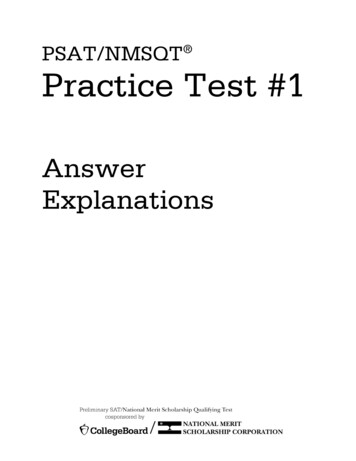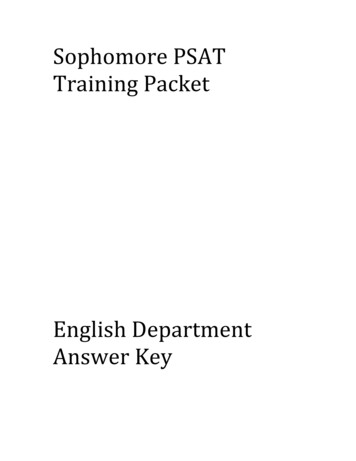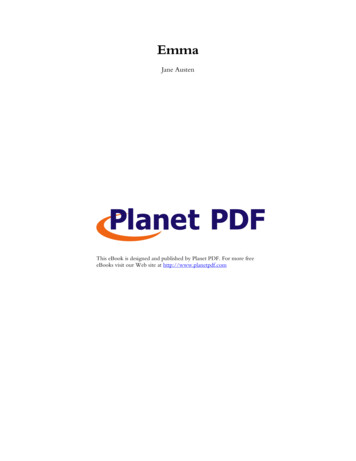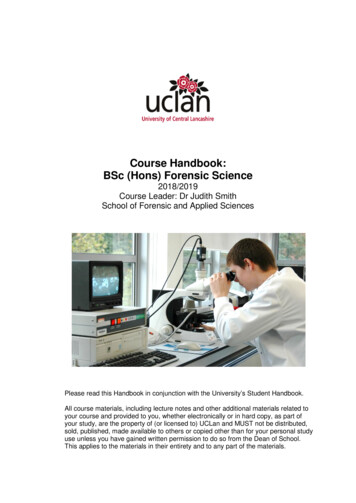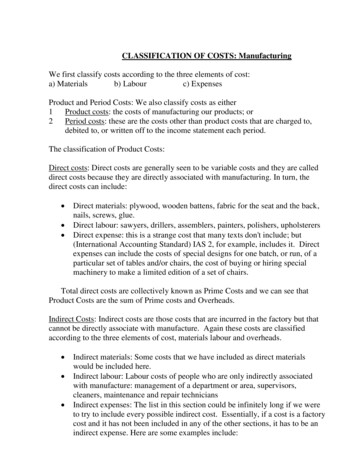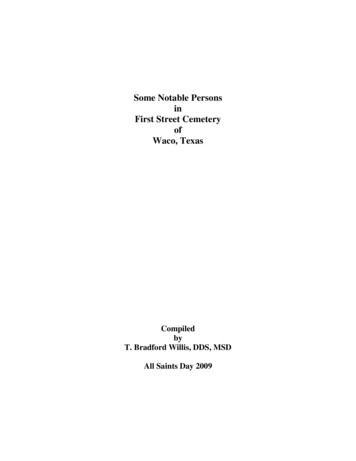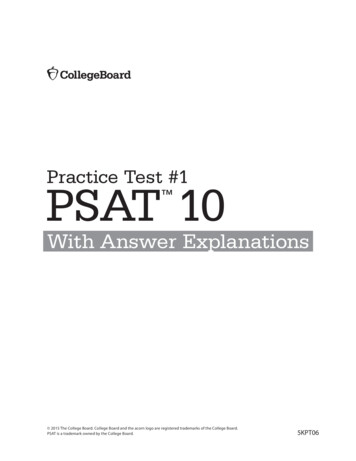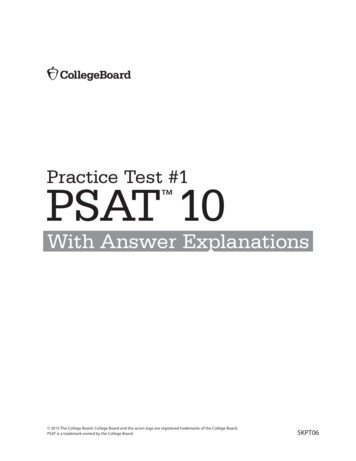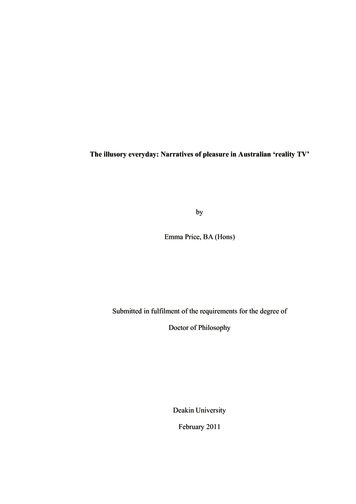
Transcription
The illusory everyday: Narratives of pleasure in Australian ‘reality TV’byEmma Price, BA (Hons)Submitted in fulfilment of the requirements for the degree ofDoctor of PhilosophyDeakin UniversityFebruary 2011
Signature Redacted by Library
Signature Redacted by Library
AcknowledgementsThis project would not have been possible without the following people.First, I would like to thank my supervisors Dr David Ritchie, Dr Keith Beattie and DrStephen Goddard for their input throughout the many stages of this research. Anextraordinary amount of thanks especially to David for his belief, guidance and manycups of tea over the last three years, and for the faith he has had in me as a studentand colleague since my Honours year.Second, this thesis literally would not have been possible without my interviewparticipants. Thanks to Helen Bullough, David Mortimer, Rick McPhee, LyndalMarks, Tarni James and Asif Zubairy for their time and insight into the televisionindustry and production. Thanks also to all my anonymous viewers for their openand enthusiastic discussions.Thanks also to the anonymous peer reviewers of my conference papers and journalpublications, for their insightful feedback on my work as the findings were publiclyaired during the research period. This input provided great opportunities to apply andrevise the emerging ideas and tangents of the thesis (see Price 2008a, 2008b, 2009a,2009b, 2009c, 2010a, 2010b, 2011 forthcoming).Third, I would like to thank the research student community at building EB. Thecamaraderie and collegiality forged by its inhabitants made coming to work aconstant pleasure. In particular, I would like to thank my original office buddiesSally Percival Wood and Neena Sachdev, my fellow ‘starters’ Edwin Ng and JanetWatson, and Amy Nethery for all her advice and motivation.Lastly, many thanks go to my family and friends for their encouragement over thelast three years. Special thanks to my parents Judy and Peter, and also to my sisterMegan for being the reassuring ‘last set of eyes’.This thesis has been a roller-coaster experience that I would not have survivedwithout the endless support and patience of my partner and dearest friend Joe – I cannever thank you enough.i
Table of T ONE: ‘Reality TV’ PerspectivesChapter One: Genre8Is there a genre? - Myths of ‘reality TV’ - Amoebic entertainmentChapter Two: Industry26Motivations - Terminologies - AudiencesChapter Three: Construction37Television narratives - Jeopardy and the ‘everyday’ - The spectacle of ‘reality TV’Chapter Four: Audiences52Studying audiences - Perception and aspirationPART TWO: Methodology & Case StudiesChapter Five: Reading for pleasure65Television narrative and Barthes’ S/Z - Pleasure of the TV textChapter Six: In their own words76Chapter Seven: Bondi Rescue90Chapter Eight: Border Security118Chapter Nine: Family Footsteps149Chapter Ten: Nerds FC176PART THREE: The Illusory EverydayChapter Eleven: The illusory everyday205Amoebic ‘reality TV’ – Dialectic awareness – Everyday s251ii
Table of Figures1.1The flow of the entertainment experience225.1Comparison of hermeneutic progressions685.2Adaptation of S/Z narrative framework for TV707.1Bondi Rescue episode structure927.2Bondi Rescue frame 11057.3Bondi Rescue frame 21067.4Bondi Rescue frame 31067.5Bondi Rescue frame 41077.6Bondi Rescue frame 51097.7Bondi Rescue enigmatic structure1148.1Border Security episode structure1218.2Border Security frame 11378.3Border Security frame 21388.4Border Security frame 31398.5Border Security frame 41408.6Border Security frame 51418.7Border Security enigmatic structure1469.1Family Footsteps episode structure1519.2Family Footsteps frame 11639.3Family Footsteps frame 21649.4Family Footsteps frame 31659.5Family Footsteps frame 41669.6Family Footsteps frame 51679.7Family Footsteps enigmatic structure17210.1Nerds FC episode structure17810.2Nerds FC frame 119010.3Nerds FC frame 219210.4Nerds FC frame 319410.5Nerds FC frame 419510.6Nerds FC frame 519710.7Nerds FC enigmatic structure201iii
AppendicesAppendix A:Audience Interview Guide251Appendix B:Industry Interview Guide252Appendix C:Bondi Rescue transcription253Appendix D:Border Security transcription260Appendix E:Family Footsteps transcription267Appendix F:Nerds FC transcription276iv
AbstractWhile previous commentary on ‘reality TV’ has approached the genre as ‘trash TV’in relation to a positivist ‘real’, this research argues that the fundamental basis of thegenre lies in the ‘illusory everyday’: constructed narratives of entertainment. Thisconcept is identified as the representation of the ‘everyday’ as illusion in ‘realityTV’, in a performance of banality and excess that is designed to connect withviewers as a source of pleasure. As a result, notions of ‘reality’ and ‘everyday’ areontologically and epistemologically problematised as relative and subjective states inrelation to television production and reception. Four key elements of genre, industry,construction and audiences are examined within a pluralist agenda of poststructuralism, phenomenology and constructivism to investigate the deficiencies inthe extant literature on ‘reality TV’. This bricolage integrates various perspectivesfrom this diverse set of theories, with particular reference to discourses of polysemy,pleasure, perception and context to establish an analytic framework for a series ofAustralian television case studies: Bondi Rescue, Border Security, Family Footstepsand Nerds FC. Textual analysis of the formats is triangulated with qualitativeinterviews with the industry and viewers in order to explore and understand ‘realityTV’ from those who produce and watch it. These personal narratives emphasise thesubjective experiences of pleasure in the construction and reception of ‘reality TV’as entertainment. Emergent design is used as the primary method, by whichprocesses and outcomes are continuously shaped and tested as the researchprogresses.The thesis concludes that ‘reality TV’ is broad and nuanced in an amorphous genre,in its production motivations and grammar, and in the individual experience ofpleasure by viewers. The ‘illusory everyday’ is proposed as the site of multipleinterpretations and pleasures, and as a framework for understanding this televisionphenomenon with three significant outcomes. First, the constant evolution anddiversity of ‘reality TV’ is identified as an amoebic genre that draws on a range oftelevision styles and techniques from informative to entertainment. Second, theconstruction of television narratives from the ‘everyday’ is essential in the triangularrelationship between the industry and audiences. The central elements of jeopardyand aspiration are examined through narrative and the use of the ‘everyday’ to createengaging viewing, as well as the significance of local production and contemporaryv
subject matter. Third, viewer engagement through entertainment is understoodthrough the pleasures of watching ‘reality TV’. The varying levels of entertainmentand engagement are negotiated by individual viewers in relation to their owninterests and experiences, in addition to their cognition of television conventions andrepresentation. The ‘illusory everyday’ therefore provides a framework for theacknowledgement and understanding of the play that is essential in viewerengagement with ‘reality TV’ in negotiating the mirage represented for subjectiveresonance and pleasure.vi
IntroductionIt was another long night at work. Between compiling the week’s format productionschedules and pitch presentations for the next commissioning meeting, I tapped out ashort email home. It read:“Reality TV is the product of a contemporary existential crisis”It was a fortuitous sequence of media posts that led me to the position ofDevelopment Coordinator for BBC Factual Entertainment from 2005 to 2006 inLondon, and the entire experience changed not only how I considered television butalso provided an awareness of industry perspectives in programme development andbroadcasting. Once back in Australia and deciding ‘what to do next’, I was remindedof that email statement and it reignited my curiosity in the phenomenon of ‘realityTV’. This research is the product of that spark.As I was to quickly learn, ‘reality TV’ is a difficult beast. As neither an avid fan norstaunch critic, ‘reality TV’ presented a wealth of research possibilities with initialsummaries supplying a wish-list of philosophical arguments in relation tointeractivity, celebrity, surveillance and voyeurism. However, as I delved further intothe extant literature, a discernible gap became apparent in the understanding of thegenre’s breadth, production and reception, and an atmosphere of criticism quiteremoved from my own experience in the industry and as a viewer.Since its inception, television has been subject to a range of developing criticalresponses, highlighting various questions of its functions and significance. Theanalysis of television is presented with a peculiar state: from the outside, it is adomestic electronic device, but through its broadcast and reception it represents anomnipresent mode of communication, displaying a variety of content and forms foraudiences. It can entertain and inform, distract and engross, as low culture and highaffect. Television has been both disregarded and celebrated in previous academicstudy due to its status as popular and mass culture. The commercial nature oftelevision and its use as commodity to audiences, in combination with its entertainingand sensational content, may be seen as aspects of ‘low’ culture. But these aspectsare not to be disregarded for this reason; they are also important in understanding thefunctions and uses of the medium (Hartley 1992, 2008; Fiske 1987; Fiske & Hartley1
Introduction2003). Ellis argues that the mass form of television “means TV belongs to theeveryday, to the normal backdrop of expectations and mundane pleasures” (1992:160). Similarly, exploration of the ‘reality TV’ phenomenon provides any number ofcontradictions in the consideration of its evolution, construction and reception. Itscriticism and praise is situated between fact and fiction, authenticity andperformance, reality and illusory, spectacle and everyday. As a result, the term‘reality TV’ is fraught with problems from the outset: can reality be on TV? Whosereality? How is it represented and for whom? The binary distinction betweenfictional and non-fictional screen texts is an artificial heuristic of theories andassumptions providing a simplistic understanding to representation and reception.For ‘reality TV’, this does not give scope for greater examination to question howprogrammes are constructed and engage. Somehow, the widely acknowledged“spectrum of manipulation involved at every stage” of television production (Dovey2000: 6) has been overlooked in the dominant criticism of ‘reality TV’, with equalomission of the narratives of the industry and viewers themselves.This thesis aims to understand Australian ‘reality TV’ through audience pleasure inthe constructed illusion of the ‘everyday’. Using ‘emergent design’ as the primarymethod, the thesis conducts an evaluation of the genre’s criticism, and offers newinsights into the production and reception of ‘reality TV’ as entertainment. The thesisargues that ‘reality TV’ is a source of pleasure, constructing and performing thenational and the self for audiences, including exploration of notions such assimulation, the ‘everyday’, perception and engagement. It establishes the ‘illusoryeveryday’ as a central element of ‘reality TV’ programmes, where people and eventsare represented as ‘real’, but in highly constructed entertainment forms. The ‘illusoryeveryday’ is fundamental to both production and audience cognition in theexpectations and conventions of the genre. The idea of illusion is not intended as anadverse judgment of ‘reality TV’ construction and reception, but rather to imply anengaging mirage or fantasy. As neither deceitful nor negative, the ‘illusory everyday’is an inherent part of a format’s operations in the construction of a dramatic andappealing ‘everyday’ that audiences are encouraged to negotiate in their engagementfor pleasure. This research challenges previous positivist, generic and audienceassumptions by mapping key elements of production and reception, and highlights2
Introductionthe essential link between the industry and audiences in the narrative spectacle of theperformance of the ‘everyday’ in ‘reality TV’.Previous studies of ‘reality TV’ have adopted a variety of viewpoints onrepresentation, but early questions of “actuality and [its] epistemology” remainunderdeveloped (Hill 2005: 9). Earlier commentary demonstrated a strong focus onthe definition of a genre with links to documentary (Nichols 1994; Kilborn 1994).The arrival of formats such as Big Brother and Survivor shifted criticism to aCultural Studies focus with emphasis on the origins of ‘reality TV’ in televisionhistory, representation of cultural politics, commercialism and economic concerns,audience interactivity, surveillance and voyeurism (Friedman 2002; Andrejevic2003; Brenton & Cohen 2003; Murray & Ouellette 2004; Biressi & Nunn 2005;Bignell 2005). Commentators appear caught between establishing the ‘trash’ natureof ‘reality TV’ or its role in ‘democratising’ television (Cummings 2002; Ouellette &Hay 2008), with little consideration of the dialectic of an ‘illusory everyday’ – ofrepresentation and actuality – and how it is achieved, received and enjoyed. Often themain source of ‘reality TV’ analysis focuses on highly sensational formats, such asBig Brother and Survivor, which are framed as exemplars of the genre. Althoughthese critiques explore numerous elements of format representation and interactivity,the concentration on a specific type of ‘game-doc’ overlooks the enormity of thefield. A ‘water-tight’ genre is difficult to define within the diversity of theprogrammes now under the umbrella of ‘reality TV’. In addition, the earlieralignment with documentary has been developed with notions of “post-documentaryculture” (Corner 2002: 255) in which ‘reality TV’ acts as an extension of the genrethat is displaced from observation to entertainment as the dominant force behind theperformance of the ‘everyday’. However, this perspective has often been limited torestrictive classifications of documentary and other television genres, and requiresfurther acknowledgement of verisimilitude in television and cultural cognition ofauthenticity. This thesis evaluates previous definitions and argues that a traditionalgenre classification is unachievable for ‘reality TV’ and constrains its understanding.It offers instead the concept of ‘amoebic’ design as an alternative genre frameworkfor a broad consideration of the cultural conventions and expectations ofcontemporary ‘reality TV’.3
Introduction‘Reality TV’ has evolved into an immensely popular form of programming and thisthesis presents further exploration of its production and reception as entertainment.This research challenges earlier views by exploring four Australian ‘reality’ formats(Border Security, Bondi Rescue, Family Footsteps and Nerds FC) with analysis oftheir construction and engagement. The four programmes were chosen for theirvarying representations of national narratives within the broad range of ‘reality TV’styles, conventions and expectations of authenticity, and inclusion of entertainmentqualities informed the selection of programmes. The choice also covers bothcommercial and public service broadcasters to highlight the breadth of the Australianindustry in production, representation and expectations of ‘reality TV’. Foraudiences, the portrayal of the ‘everyday’ is significant as a representation of culturalidentity with the local production of global format ideas emphasising dominantnational values and experiences. The current success and constant development of‘reality TV’ signals its importance for television broadcasting, and therefore it isequally important to examine how narratives are being portrayed and received byaudiences as an expression of entertainment and culture. This thesis argues for the reevaluation of ‘reality TV’ in broadcasting as constructed entertainment in itsspectacle, narrative and performance of the ‘everyday’. The chosen programmes aredemythologised to uncover a superficially simplistic, yet highly complex form oftelevision, aimed at and received for the subjective pleasures of viewers. The conceptof the ‘illusory everyday’ is developed and deployed as a theoretical framework forthe analysis of television formats to reveal the qualities in both production andreception that are essential for its construction and entertainment. The use of the term‘everyday’ is problematic in that its invocation can often be “a sleight of hand thatnormalises and universalises particular values, specific world-views” (Highmore2002: 1). Highmore identifies the ambivalent term as possessing an “unspecificgravity” in signifying not only immediate, daily life, but as a quality of‘everydayness’ in the invisibility of the banal and familiar (2001: 1). The ‘everyday’is defined in this research primarily in relation to de Certeau (1984) as a way ofquestioning and understanding culture in the minutiae of ‘ordinary’ actions andthoughts: to make visible the invisible. In this way, the ‘everyday’ is not definedthrough predetermined meanings, but as a “contested and opaque terrain”(Highmore: 2002: 1) that is highly dependent on the relative context of the subject.4
IntroductionThis research adopts Kellner’s view that television research should be multiperspectival to avoid “one-sidedness” (2005: 43). Perspectives and critical methodsin both textual and audience research frameworks have undergone significantparadigm shifts that are discussed further in Chapters Three to Six. A bricolage ofthese approaches (Denzin & Lincoln 2005: 4) is thus employed to understandtelevision culture through genre, production, narrative theories and audience studies.This position is also situated with Deleuze and Guattari’s rhizomic approach to avoidstructured hierarchies, and to use frameworks as “lines of flight” (2004: 23) as linksbetween theoretical and empirical discourses. In this way, several frameworks andtheories are introduced and developed into a methodology for the case studies.Analysis of the screen texts is situated in post-structuralist frameworks in order toaddress the plurality and polysemy of television narratives, and the multiplicity ofmeanings and responses possible from viewers in their experience of television.Barthes’ S/Z (1970) provides a framework that privileges the role of the reader in theintroduction of a ‘writerly’ approach as a non-prescriptive examination of narrativein the activity of constructing meanings in the infinite play of signification. As aresult, it presents a reflection on the act of reading and identifies differences in therelationship between reader and text. This framework is coupled with Barthes’ laterstudy The Pleasure of the Text (1973) that establishes a physical mode of pleasureproduced only through the reading of a text. In the combination of Barthes’frameworks, the interpretations and pleasures of ‘reality TV’ viewers can beidentified in their individual responses to and experiences of the formats. Thisparadigm of subjective narratives is maintained in qualitative research grounded indiscourses of constructivism to allow a flexible process without preordinacy ofsalience, and to acknowledge the ideographic social context of the qualitative cohort,the visible role of the researcher and the limitations of defining the audience as anaccessible entity (Lincoln & Guba 2003). This methodology is also connected tophenomenological approaches of individual perception and experience. Narratives ofboth the industry and viewers are presented “in their own words” (Hall 1986: iv; Lull1990: 18) and triangulated with text analysis as a reflection of the construction andreception of ‘reality TV’ formats as entertainment. This process provides anemergent design for the consideration of the ‘illusory everyday’ as a liminal spacebetween the ordinary and format ‘world’ for its production and audiences. Additionaltheories from de Certeau, Bakhtin, Baudrillard, and Merleau-Ponty are employed to5
Introductionexplore the representation and engagement of ‘reality TV’ as pleasurable experiencesin constructed narratives of entertainment.The thesis is divided into three sections in an unconventional structure. This design isa deliberate choice to reflect the emergent design of the research, in which processesand outcomes are continuously shaped and tested as the research progresses. In thisway, this unorthodox structure avoids fixed or preordained positions and encouragesthe exploration and linkage of various theoretical perspectives. Part One introducesthe four key elements essential to the research examination of ‘reality TV’: genre,industry, construction and audiences. Each of these chapters considers previouscommentaries and explores theoretical frameworks as shifting paradigms in theemerging perspectives of the thesis in entertainment, production, narrative andreception. These chapters are part of the emerging research narrative to establishprevious discourses and locate new possibilities in ‘reality TV’ understanding. PartTwo presents the parallel research methodologies of post-structuralism andconstructivism, before the four case study chapters that introduce each chosen formatand detail viewer and industry responses with analysis of construction and pleasure.Part Three draws together the arguments and findings of the preceding sections forfurther exploration of the ‘illusory everyday’ in ‘reality TV’ production andreception.6
PART ONE‘Reality TV’ Perspectives7
C H AP T E R O N EGenreThe use of the term ‘reality TV’ signals or implies a programming type, with thecommon label now a ‘catch-all term’ as a “convenient shorthand for many kinds oftelevision” (Brenton & Cohen 2003: 8). However, the issue of genre continues to bea major concern in the criticism and analysis of ‘reality TV’. Previous attempts todefine conventions, styles and expectations for ‘reality’ programme examination as agenre has implicated the demarcation of necessary parameters from an evolving fieldof production. This approach inevitably sees the exclusion of some formats from agenre definition for the sake of coherent and systematic categorisation, oralternatively, the need for ambiguity in order to cover “a range of popular factualprogramming” (Hill 2005: 41). Furthermore, the classification of genre can be arguedas an abstract and cultural construct through a subjective identification of commontextual qualities. Therefore, the question remains whether a genre can be identifiedfrom the current and historic forms of ‘reality TV’ programmes and to what extent itsprevious criticism has inhibited understanding.‘Reality TV’ programming has defied any clear formula primarily because of itsvariety of forms. Programmes have evolved substantially across its lifespan to date,where contemporary choices of subject matter and representation styles aresignificantly different to that of the previous two decades. Specific genre boundariesare elusive for the identification of particular televisual styles and techniques as thesecan be diverse, and at times, oppositional. In addition, ‘reality TV’ constantlyreinvents itself to maintain its currency and appeal, consequently avoiding therecurring predictions of its demise. As a result, ‘reality TV’ appears as moreamorphous across televisual styles and techniques rather than adhering to strictparameters. Traditional consideration of genre from literary or film theories istherefore redundant in its criticism, and requires a cultural approach suggested byMittell to account for the “specific industry and audience practices unique totelevision” (2005: 37), and specifically in this research for ‘reality TV’.8
GenrePrevious studies of ‘reality TV’ have been dominated by comparison withdocumentary. While this may be historically based in earlier commentaries where theformats discussed primarily involved ‘on-the-job’ footage of emergency services(Kilborn 1994; Nichols 1994, discussed below), their parameters for analysis arelimited when considering the range of ‘reality TV’ present in current broadcasting. Inparticular, the approach in new millennium formats such as Big Brother and Survivorhas expanded the possibilities of construction and spectacle from the ‘everyday’,leading to claims of “lowest common denominator” and ‘trash’ television (Mosley2000: 4; Dovey 2000: 83). These concerns are part of a ‘panic’ regarding thecontemporary trends in broadcasting and the ‘loss of the real’ in television. However,the efficacy of this perspective is questionable: in the medium’s mediated state, isthere any ‘real’ to have lost in the first place?Neale’s concept of genre as “systems of orientations, expectations and conventionsthat circulate between industry, text and subject” (1980: 19) is a useful foundationfor further examination of ‘reality TV’ as a category of programming. The use ofdocumentary techniques as a ‘claim to the real’ supports the comparison withdocumentary, but this comparison ultimately neglects to recognise the importance ofentertainment in ‘reality TV’. This thesis argues that entertainment plays an equallyimportant role in the aesthetics and context of ‘reality TV’, and in this way, informsboth programme construction and viewer engagement. With this in mind, explorationof industry, text and audiences is crucial to achieve an understanding of ‘reality TV’in terms of its conventions and appeal.Is there a genre?Although its origin is contested, the term ‘reality TV’ is thought to have enteredcommon usage in the early 1990s, as a development from the ‘infotainment’ era ofthe 1980s in television (Bonner 2003: 23-4; Hill 2005: 24; Brenton & Cohen 2003:13). An important distinction to note from the outset is between the purpose of theprogramming and its title. Although the term ‘reality TV’ is relatively new inconstituting an “expansive and distinctive televisual movement” (Jermyn 2004: 88),the aim to show ‘real’ people and events on television has been present throughoutthe history of television. ‘Reality TV’ has become a buzzword for both the industry9
Genreand audiences to highlight particular production structures and expectations.However, this has also caused some misinterpretations that will be considered inChapter Two. Although most critics agree that there are specific styles andtechniques involved in ‘reality’ formats, concrete definitions have been elusive dueto the specific aims of its criticism, which according to Bourdon serves “to condemn,to support, to defend, to debate” (2008: 67). As a result, the common classificationsin current literature “err on the side of inclusiveness” (Nabi et al. 2003: 304) in orderto unite the range of programmes within its “discursive, visual and technologicalclaim to the ‘real’” (Holmes & Jermyn 2004: 5). Therefore, the idea of a specificgenre of ‘reality TV’ is questionable and requires further consideration.At its simplest level, ‘genre’ is described as a specific category, distinctive type orstyle (Feuer 1992; Gledhill 1999; Neale 2000). As an analytic tool for literature andfilm, the study of genre focuses on the division and classification of texts throughidentification of repetition and variations, implying that works can be categorisedregardless of unique qualities, and emphasises structure and intrinsic textualelements. Neale states that genre guarantees coherence for texts by “institutionalizingconventions” (1981: 15) as part of its pleasure and function, and as a result argued tooperate “as ‘horizons of expectation’ for readers and as ‘models of writing’ forauthors” (Todorov 1990: 18). However, these coherent categories are ultimatelyabstract and culturally constructed in that they rely on the subjective judgement ofintegral features and boundaries. Mittell describes this as a ‘textualist assumption’that looks “inward at texts to explain and delimit the formal mechanisms constitutingthe essence of any given genre”, linked to aesthetic and formalist paradigms (2004:2-3). This discourse is extended through theoretical arguments such as Todorov(1975) in historical or theoretical genre approaches derived from critical observationor pre-existing cultural ideas, and Altman’s (1984) semantic/syntactic argumentframed by Feuer (1992) as aesthetic, ritual and ideological approaches to considersystems of conventions, author/reader exchange, or structures of dominant idealsrespectively. By moving away from the sole centrality of the text, genre can act as adiscursive practice in order to position texts into frameworks of particularconventions and expectations that rely on the relationship between the work itself, itssource and its audience.10
GenreFor television, genre consideration requires acknowledgment of the production,marketing and viewing of programmes, with identification of specific and commonconventions. This also allows for management of television’s programming rangethrough reduction into comprehensible divisions; an important factor in broadcastscheduling and a reassuring guide for audiences (Turner 2001: 5). Fiske describestelevision as a “highly ‘generic’ medium” with clear categories between programmesdetermined by similarity (1987: 109-10). However, the application of film andliterary genre frameworks to television is problematic due to the differences infunction and reception. Television genres are increasingly less specific through racteristicsofintertextuality, pastic
cups of tea over the last three years, and for the faith he has had in me as a student . Chapter Three: Construction 37 Television narratives - Jeopardy and the ‘everyday’ - The spectacle of ‘reality TV’ . summaries supplying a wish-list of philosophical arguments in relation to
